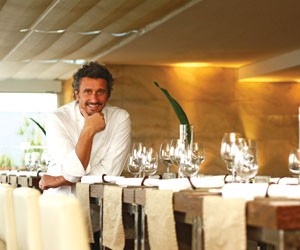Emmanuel Bassoleil
Executive Chef
Hotel Unique and Skye Restaurant
Sao Paulo
Chef Emmanuel Bassoleil is the mastermind behind the cuisine served at Skye, the rooftop restaurant at Hotel Unique in Sao Paulo. In an exclusive interview with Meetings Focus International, this French-born chef shares his insights about what makes Brazil such a great place to dine.
How would you describe the evolution of Brazilian cuisine?
The ’90s was a period of big changes because there were two very important moments. First was the Brazilian market opening up to imports. This propelled the utilization of new products in cooking, while Brazilian producers were pushed to discover new ingredients and improve manufacturing and production.
With the entrance and appearance of new products in the Brazilian gastronomy scene, there was a need for specializing the manpower, learning how to use and create dishes in the best way possible. At that point, the second moment of transformation started, with the opening of gastronomy and culinary schools. Many international chefs dedicated themselves to the professional [education] of Brazilian students. In my view, it was the first step to the professionalization and specialization of Brazilian gastronomy.
The result of these transformations was the increase in the quality of the execution of the dishes, of their creation and especially in the extraordinary level of service we have in Brazil, which is above that seen in many other countries.
What should visitors expect while dining in Sao Paulo and Rio?
In general, I believe the real trend in Brazil is to uncomplicate the gastronomy so that everybody can understand and access it—simplify it to make the flavors of the ingredients be felt and the technique appreciated. I believe the main idea now is to put the Brazilian gastronomy in the same level that the Brazilian tourism is, making the visitors want to know the country because of its food.
What should visitors try, and what should planners try to include on their menus?
The fruit in Brazil is so special, and I suggest trying them in the food and drinks as well. There is also the unique cuts of meat and the diverse techniques to cook it. The “carne seca”—sun-dried meat, roughly translated—is a traditional kind of meat, very tasteful and versatile. Don’t forget to try a real “pao de queijo” (cheese bread). And for dessert, the classic “Romeu e Julieta” (white cheese) or “Queijo de Minas.” It’s a cheese from Minas Gerais, a state right above Rio and Sao Paulo, combined with “goiabada” (guava candy).
Can you recommend cooking schools, classes or other ways that groups might incorporate F&B into their agendas in Brazil?
At Esccola Wilma Kovesi (www.wkcozinha.com.br) and at Atelier Gourmand (www.ateliergourmand.com.br), it’s possible to get short courses. I also recommend Alain Ducasse’s courses in Sao Paulo and Rio (www.estacio.br/gh/gastronomia) because he’s a super-recognized French chef teaching in Brazil. It’s also important to mention the longer cooking courses offered by the universities Anhembi Morumbi and Senac.



